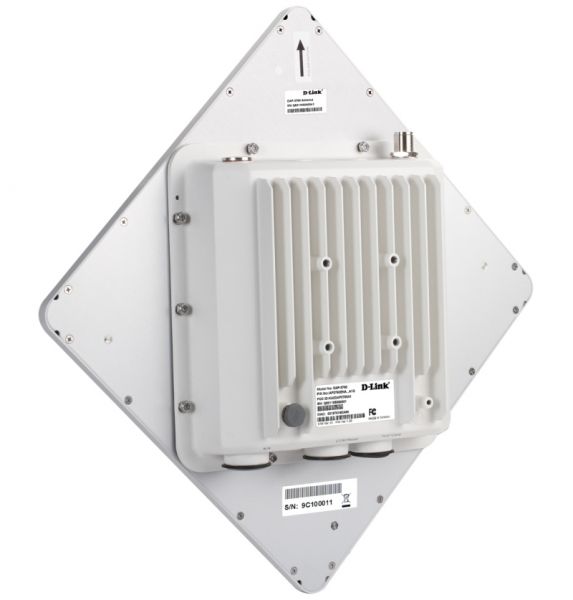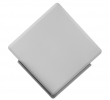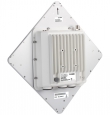
DAP-3860מיועד לפרויקטים
תאור
The D-Link Long Distance Wireless Outdoor Bridge is designed to provide long distance wireless connectivity in areas where a wired network infrastructure is prohibitive. The integrated Intel® IXP Networking Processor operates on non-licensed spectrums, offering low cost, durable, and reliable outdoor wireless broadband connectivity. When operating with an unobstructed line-of-sight, the D-Link wireless backhaul solution is able to achieve connections at distances of up to 40km. These impressive ranges are possible through the application of a TDMA modification to the MAC layer of standard 802.11.
Extend Your Network
The DAP-3760 and DAP-3860 Outdoor Bridges are designed for harsh outdoor environments, providing highly reliable, stable transmissions, and excellent performance in almost any setting. A 23dBi antenna ensures transmission quality while Intel TDMA allows the bridges to attain speeds of up to 8Mbps at distances of up to 100km (using relay). The DAP-3860 uses two radio cards with link aggregation technology to double throughput for point to point operation.
An Affordable Backhaul Solution
The D-Link Long Distance Wireless Outdoor Bridge offers a reliable alternative to backhaul solutions such as WIMAX and GSM. When rugged terrain prevents the installation of a standard wired network backbone, a wireless outdoor bridge can be deployed. In fact, a 5GHz wireless solution is ideal in sparsely populated areas where electronic interference is minimal. An outdoor bridge can be installed with minimal additional cabling thanks to Power over Ethernet capabilities.
Connect Rural Areas to the Internet
The DAP-3760 and DAP-3860 Outdoor Bridges can be used to connect urban hubs with rural endpoints. Internet access is deliverable via one or many intermediate nodes as part of a flexible architecture that is simple to deploy, manage, and maintain. Security over these distances is assured through the use of WEP, TKIP, and AES encryption schemes.
Keep Even the Most Remote Users Online
A wireless backhaul installation can provide network access for remote offices and academic buildings areas that cannot be reached by cable. For instance, rural medical clinics can use the system for telemedicine applications, to exchange vital patient data with city hospitals and health care centers.
מאפיינים כללים
System
• CPU
• IXP425, 533MHz
Memory
• 16MB Flash
• 32MB SDRAM (modified to 64MB)
Power
• Power over Ethernet (PoE Injector Output 19,3 W)
Radio
• Module RF *
• FCC: XA-632AH
• CE: AG-623C
Operating frequency *
• FCC: 5,725 ~ 5,850 GHz
• CE: 5,470 ~ 5,600 GHz, 5.650 ~ 5.725 GHz
RF modulation
• 802.11a: OFDM (BPSK, QPSK, 16-QAm, 64-QAm)
Output power RF *
• 24dBm at Radio for FCC (Band 4)
• 30dBm EIRP for ETSI 301 893 (Band 3)
Sensitivity
• -90 dBm @ 6 Mbps / sec
• -73 dBm @ 54 Mbit / s
Certificates
• FCC Class B, CE, IC, C-Tick, NCC
Operation / Software
• Operating Modes
• Bridge
Security
• WEP64/128/152, WPA-PSK/WPA2-PSK, TKIP, AES
Bandwidth Management
20MGts/40MGts
Super A / G
• Technology Fast Frames, Bursting, Compression
Link Aggregation
• Increased capacity
Intel TDMA
• Data transmission over long distances
Distance in meters
• Auto ACK-Time Adjustment
Statistics
• Wireless LAN and Ethernet
Link Test
• Checking the Wireless Connection
Configuring and Managing
• Management of Web-based (Secure SSL)
• Command line interface (SSH or RS-232 (9600))
• Utility on Windows
• SNMPv2
Software Update
• Management through Web / Windows
Physical parameters / Interfaces
• Ethernet
• 10/100 BaseT x 1 supports auto-negotiation, auto-negotiation
RS-232 (COM)
• RS-232 (UART) in RJ-45 Form Factor (for debugging)
Audible alarm
• Time Signal
Reset Pin
• COM Port (2 Pin)
Performance of the antenna
Type of antenna
• Internal directional antenna with high gain
• External directional antenna with high gain
Gain
• 23dBi
Frequency range
• 5400 ~ 5850 MHz
HPBW (Horizontal)
• 10°
HPBW (Vertical)
• 10°



